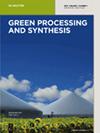Comparative analysis of bio-based amino acid surfactants obtained via Diels–Alder reaction of cyclic anhydrides
IF 3.8
4区 工程技术
Q2 CHEMISTRY, MULTIDISCIPLINARY
引用次数: 0
Abstract
Current changes in environmental legislation and customer demands set an urge for the development of more sustainable surfactants. Thus, the objective of this work was the development of novel environmentally friendly amino acid surfactants. Combining Diels–Alder cyclization of myrcene with maleic or citraconic anhydride followed by ring opening with amino acids enabled a synthesis route with a principal 100% atom economy. Variation of amino acids resulted in a large structural variety of anionic and amphoteric surfactants. Lysine gave access to either a mono-acylated product bearing a cationic side chain or a bi-acylated gemini surfactant. First, anhydride precursors were synthesized in yields of >90% in a Diels–Alder reaction under microwave radiation and subsequent amino acid coupling in aqueous environment gave fully bio-based surfactants in good yields and purity. Physicochemical characterization showed an enhanced decrease in surface tension upon addition of amino acids to the myrcene–anhydride backbone, resulting in a minimal value of 31 mN·m−1 for gemini–lysine. Foamabilitiy and foam stability were significantly increased at skin-friendly pH 5.5 by incorporation of amino acids. The carboxylic groups of surfactants with arginine were esterified with ethanol to access cationic compounds. Comparative analysis revealed moderate antimicrobial effects against yeast, Gram-positive bacteria, and Gram-negative bacteria.通过环酐的 Diels-Alder 反应获得的生物基氨基酸表面活性剂的比较分析
目前,环境立法和客户需求的变化促使人们开发更具可持续性的表面活性剂。因此,这项工作的目标是开发新型环保型氨基酸表面活性剂。将麦皮烯与马来酸酐或柠康酸酐的 Diels-Alder 环化反应结合起来,然后用氨基酸开环,这样的合成路线主要实现了 100% 的原子经济性。氨基酸的变化产生了大量结构各异的阴离子和两性表面活性剂。通过赖氨酸可以获得带有阳离子侧链的单酰化产物或双酰化的双子表面活性剂。首先,在微波辐射下通过 Diels-Alder 反应合成了酸酐前体,产率大于 90%,随后在水环境中通过氨基酸偶联得到了完全生物基的表面活性剂,产率和纯度都很高。理化表征结果表明,在亚麻酐骨架上添加氨基酸后,表面张力的下降幅度增大,使 gemini-lysine 的最小值达到 31 mN-m-1。在亲肤 pH 值为 5.5 的条件下,加入氨基酸可显著提高泡沫稳定性。含有精氨酸的表面活性剂的羧基经乙醇酯化后可获得阳离子化合物。对比分析表明,这种表面活性剂对酵母菌、革兰氏阳性菌和革兰氏阴性菌具有适度的抗菌效果。
本文章由计算机程序翻译,如有差异,请以英文原文为准。
求助全文
约1分钟内获得全文
求助全文
来源期刊

Green Processing and Synthesis
CHEMISTRY, MULTIDISCIPLINARY-ENGINEERING, CHEMICAL
CiteScore
6.70
自引率
9.30%
发文量
78
审稿时长
7 weeks
期刊介绍:
Green Processing and Synthesis is a bimonthly, peer-reviewed journal that provides up-to-date research both on fundamental as well as applied aspects of innovative green process development and chemical synthesis, giving an appropriate share to industrial views. The contributions are cutting edge, high-impact, authoritative, and provide both pros and cons of potential technologies. Green Processing and Synthesis provides a platform for scientists and engineers, especially chemists and chemical engineers, but is also open for interdisciplinary research from other areas such as physics, materials science, or catalysis.
文献相关原料
| 公司名称 | 产品信息 | 采购帮参考价格 |
|---|
 求助内容:
求助内容: 应助结果提醒方式:
应助结果提醒方式:


